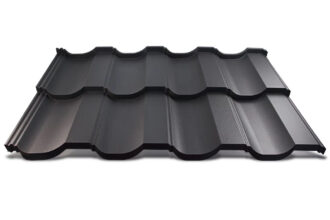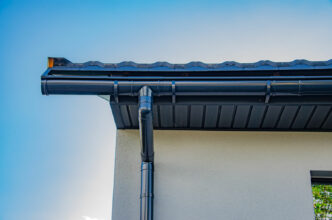Roofing is the top layer that affects both the appearance and tightness of the roof. Before you decide on a specific type of coverage, check out the most important information about each material. Knowledge in this area will make it easier for you to make an informed choice and allow you to adjust the type of coverage to your budget.
Types of roofing
There are many types of roofing available on the market. The different materials differ in quality, tightness, durability and also aesthetics. Let’s take a look at the most important and most frequently chosen types of roofing.
Bitumen roofing
Bitumen roofing is, above all, very flexible and versatile. Many people also appreciate them for their aesthetic qualities. The group of bituminous coverings primarily includes:
- bituminous roofing tiles,
- corrugated bitumen panels,
- bitumen membranes.
This type of covering is produced from a material of organic origin, i.e. a waterproof bitumen compound. The material provides excellent moisture insulation. The thicker the bitumen coating, the tighter the structure. Roof tiles or asphalt slabs are characterized by high resistance to extreme temperatures. On top of that, they are very lightweight so do not require the installation of heavy supporting structures. Another advantage of this type of covering is to ensure effective ventilation of the roof.
The biggest disadvantage of bituminous coatings is the complicated assembly, which requires the use of the right temperature. Otherwise, the connection of the material may turn out to be unstable, and thus leaky.
Tile roofing
Roofing made of sheet metal is very popular. In this category we distinguish:
- flat sheet,
- trapezoidal sheet metal,
- sheet metal roofing.
The first two variants are most often used to cover large-scale production halls and warehouses or outbuildings, garages and gazebos. However, it is the metal roofing tile that is a material that cannot be passed indifferently in the context of residential buildings. Visually, the tile resembles a classic ceramic tile. However, it is much lighter than it, resistant to harmful weather conditions and easy to install.
The light weight of the metal roof tile means that it can also be used in the case of a less solid roof truss. This material is also very tight, so that moisture is not able to penetrate into the roof structure. In our offer you will find metal roofing tiles of the highest quality in various dimensions and color variants. This type of coverage will work in any single-family home!
Clay tile roofing
Ceramic roof tiles are, above all, very aesthetically pleasing. They blend in perfectly with buildings designed in both classic and modern styles. This material is available in many shapes and colours, so you can easily choose a model that visually matches the shape of the building.
When opting for clay tile roofing, you have to expect high investment costs. In addition, the ceramic material is much less resistant to damage than sheet metal, for example. Installing clay roof tiles is quite a challenge and requires experience and the right tools. Even minor mistakes made at this stage can result in the structure unsealing.
Thatch roofing
This is a very interesting solution that will work particularly well for rustic buildings. Straw used to be the main raw material used for thatch roofs. It has now been replaced by a much more durable reed. A roof created from such material can last up to 50 years! The durability of this raw material is influenced by the wax and silica in it. They are what make the reed hard, thick and resistant to fire and adverse weather conditions. What’s more, heavy rain is an ally of the reed thatch, as it removes any dirt from it.
A thatched reed roof requires regular maintenance and the filling of any cavities which incurs additional costs. In addition, this type of covering will only work well on roofs with a steep pitch, and the material itself is relatively expensive.
Transparent roofing
Transparent roofing materials, usually made of PVC, are lightweight and allow a large amount of light to pass through. They are typically used to finish gazebos, terraces or balconies. Plastic roofing clearly exposes the roof truss and other structural elements.
Tar paper roofing
Currently, tar is more often used as a protective layer under the main roofing. This is primarily due to aesthetic aspects. Tar paper does not look very good on most roofs, especially those with steep pitches. In addition, the material is difficult to install and gets very hot during high temperatures.
Does the shape of the roof affect the type of roofing?
In theory, most coverings can be used on any type of roof. However, practice shows that this is not always a sensible and economical solution. The shape of the roof is crucial in terms of the choice of roofing material. For roofs with numerous folds, it is advisable to opt for small-format coverings (e.g. modular tile, clay tile). This type of roofing offers a great deal of freedom in terms of flashing and shaping the curvature of the roof.
If the roof is simple in form and large in size, a made-to-measure tile will work best. Large sheets of material are easy to install and cost-effective. By ordering a made-to-measure roofing tile, you don’t have to worry about wasting material. When choosing the type of covering, also consider the angle of the roof. Usually, manufacturers provide information on what slope specific models are designed for.
Choosing a roof covering – the most important aspects
The choice of roofing should not be a matter of chance. So what should guide your purchase?
- Climatic conditions – some areas are more exposed to heavy snow or rain, others to increased sunlight or wind. Take into account the climatic conditions in your region to choose a roofing material that is airtight and durable.
- Zoning guidelines – in some places the colour of the roof or the type of covering is imposed in advance. Failure to comply with certain rules may result in a financial penalty.
- Durability of the roofing – even the most beautiful roofing will be a poor investment if it proves to have little durability. Remember that roof structure repair work is very expensive.
- Material availability – make sure the material that catches your eye is available in the colour and size you need.
- The visual aspect – your home is your business card, so the aesthetics of the roof are very important in terms of the visual coherence of the whole building.
Remember to hire specialist professionals to install your roofing. The materials they will use should come from reliable and reputable manufacturers! This will save you money on possible repairs in the future.


